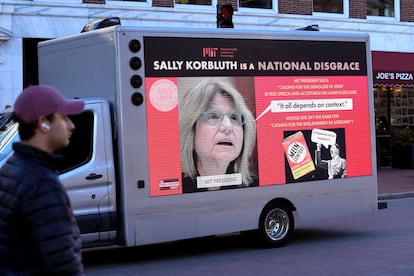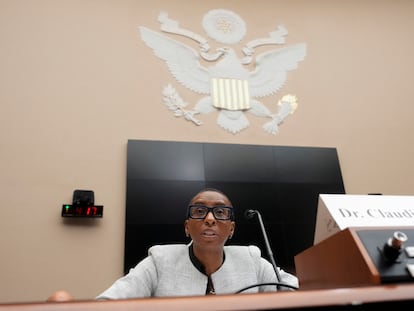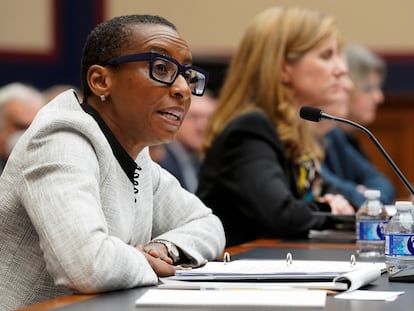Gaza conflict prompts the largest mobilization on US campuses since the Vietnam War
The student protest movement is primarily pro-Palestinian and occurs in the context of pressure on university leaders amid accusations of antisemitism


Based on the struggle for civil rights, the Vietnam War unleashed a massive mobilization on U.S. campuses. Since then, few events have been able to mobilize students like the Gaza war, which shares some key features with the earlier conflict: the imagery of a powerful army subjugating a helpless population; generational differences (young Americans are more pro-Palestinian than their elders); the conflict as a catalyst for broader trends; and, finally, the belief in opposition to the war as a just cause in both cases.
But there are also many differences between the two. Race is the first important distinction. In the 1960s, campuses were mostly white, while today’s campuses have many more students of other races, who empathize with the Palestinian struggle as a form of final resistance to colonialism. Protesters against the Gaza war agree with the denunciation of police brutality against African Americans that rocked the U.S. in 2014 and 2020. But even in the racial protests of the last decade, the demonstrations did not reach the level of polarization and virulence of the current ones, in which accusations of antisemitism have become another casus belli added to the war itself.
Today’s anti-war protest differs from the one in the 1960s that was encouraged by the beat generation and the hippie movement, because the former pits equals against equals: Jewish students who say they feel insecure in the face of their own peers and the latter’s calls for intifada. The tension has moved from the bottom up, reaching university leaders and igniting a political firestorm a year before the elections. Indeed, the situation has reached an even higher level with a federal investigation examining whether a dozen schools, including some of the country’s most prestigious ones, have violated Title VI of the Civil Rights Act of 1964, legislation that prohibits discrimination on the basis of race, color or origin, by allowing antisemitic demonstrations.
As campus demographics have changed, so too have the political pressures and demands on university leaders, including from many donors. The latter have placed the presidents of the University of Pennsylvania, Harvard University and the Massachusetts Institute of Technology in an untenable situation. A case in point: Liz Magill resigned after a donor threatened to withdraw $100 million in funding. Harvard’s Claudine Gay is still on the hot seat, not just for failing to expressly condemn hateful messages on her campus at a congressional hearing but also for accusations of plagiarism, which have forced her to revise several articles. Like Gay’s, Sally Kornbluth’s picture appears on banners and posters with disparaging slogans. The controversy over alleged antisemitism is the Republicans’ new battering ram against opponents.
Omer Bartov, a professor of Holocaust and Genocide Studies at Brown University, summarizes the debate’s background. “There has been a general polarization of political opinion since Donald Trump’s election as president in 2016. That polarization has found its way onto campuses as well. At the same time, there has been a growing tendency to silence or even ban the opinions, speeches and writings of those expressing views opposed to one’s own. That has occurred on both the Right and the Left. Among conservatives, that trend has manifested itself most notably in the bans on speeches and writings that are critical of American history and racism; among liberals, it occurs against those using terms and terminology deemed offensive or inappropriate. The former has been evident at several schools in Republican states; the latter has become common at many liberal universities.”

The Gaza war protest movement is largely decentralized, although it has links to national platforms, such as the U.S. Campaign for Palestinian Rights, the largest in the country. “We have seen students leading our communities across the country. Despite attempts to silence them, students continue to organize and speak out in support of an immediate ceasefire and a free Palestine. We proudly support their work,” a spokesperson explains. The internet offers inspiration and, at times, advice for protesters. In 2014, when Mike Brown, an unarmed black man, was killed by police in Ferguson, Missouri, leading thousands of people to protest in the streets for days, Palestinian Americans on social media offered suggestions for how to protect oneself from tear gas. Nine years later, at the University of California, Santa Barbara, and elsewhere, black and Latino students are the vanguard of the pro-Palestinian movement.
Last week, Joey Ayub, who is of Palestinian-Lebanese descent and edits a podcast on the conflict, wrote that young Americans are more likely to conceptualize the Palestinian cause as an issue linked to the struggle for racial justice. Ayub says that there is a “visual parallel,” an image that is easy to assimilate: that of a soldier or police officer dominating a space inhabited by a subjugated population, whether in a West Bank city or in a majority-black neighborhood in the United States. He also argues that 2014 was a pivotal year in younger Americans’ understanding of the conflict: that summer, as protests erupted in Ferguson over the death of a Black youth, an offensive against Gaza, the so-called Operation Protective Edge, killed some 2,250 Palestinians and 73 Israelis. Ayub recalls that advice on social media about how to deal with tear gas was “symbolically a very powerful thing.”
The end of the semester and Christmas break seem to have restored calm on campus, but only in appearance. At New York’s Columbia University, it is not difficult to find Palestinian flags, even at the headquarters of a student fraternity. In mid-December, the unrest at Harvard University came from outsiders. Columbia has managed to escape the noise thus far, despite being the epicenter of the mobilization in the war’s early days, because of initiatives that combine prohibition and dialogue: among others, a new forum for specific debate over the conflict amid the ban on two pro-Palestinian groups for violating the rules authorizing demonstrations (neither of them has responded to this newspaper). Many wonder how long it will take for Columbia, one of the universities under federal investigation, to be swept up in the fury engulfing other campuses.
Israeli Shai Davidai, a professor at Columbia’s business school and one of the first to denounce the direction’s inaction, says that, in practice, nothing has changed, despite the aforementioned measures. “Last month, the university suspended two pro-Hamas organizations from campus. On the 8th, under pressure from the congressional hearing [three days earlier], the university declared that calls for violence and genocide violate the institution’s rules. On the 11th, the university communicated that a planned protest was unauthorized and therefore would not take place, but on the same day, the unauthorized protest did take place,” he emphasizes. “It was organized by the two organizations that had supposedly been suspended, and there were chants of slogans calling for violence, something the university claims to be against. In short, nothing is being done about it. As we saw during the shameful congressional hearing, today’s universities are not run by leaders, but by lawyers,” he decries.
Ignorance of the context
Davidai refers to the December 5 appearance of the presidents of the University of Pennsylvania, Harvard and MIT before the House Education Committee, during which they took a beating from the Republicans, especially Elise Stefanik. The far-right Republican representative’s fifteen minutes of fame sank the three women’s reputations and tarnished the three institutions’ images, but her role was an exercise in political opportunism. “There is little doubt that representatives like Elise Stefanik —who has expressed sympathy for the antisemitic so-called Great Replacement Theory and coddled the Republican Party’s most radical factions— was not interested in fighting antisemitism in her questioning of the university presidents. In addition to pursuing her own political ambitions, Stefanik seeks to expose universities as bastions of the radical leftist elite that censor all other opinions,” Bartov explains. He warns of the need to “beware of censorship on campuses by both sides, while protecting students and faculty from hate speech, incitement and intimidation.”
Israeli-born Professor Bartov believes that the university presidents’ equidistance in showing sympathy for all victims and trying to please everyone (faculty, students, donors) “has only made things worse.” He observes that “instead of expressing their own views clearly and directly or stating that they are not in a position to make public statements about political events in other parts of the world, they opted for legalistic language that completely undermined their authority as the leaders of large institutions.” Moreover, Bartov adds, “even at elite universities like Harvard, MIT and the University of Pennsylvania, as well as my own, Brown University, the vehemence of student protests against Israeli policies, and equally vehement attacks on those protests as antisemitic, often lack a real understanding of the complexity of the situation on the ground in Israel and Palestine.”
Just a couple of examples serve to illustrate that last point: many of the young people who chant slogans like “From the river [Jordan] to the sea, Palestine will be free” (a slogan that Jewish students see as a call for expulsion or genocide), are unaware of what exactly the expression refers to. According to a recent Economist/YouGov poll, some believe that the Holocaust is a myth. According to a recent Harvard CAPS-Harris poll, two-thirds of voters between the ages of 18 and 24 believe that Jews as a class are oppressors and should be treated as such. Some 67% of those in that age bracket say the female presidents questioned in Congress did more than they needed to do to tackle antisemitism on campus, compared to 62% of all respondents, for whom the three women fell far short. According to the poll, one in five young Americans believe the Holocaust is a myth.
The 'official' definition of anti-Semitism
In addition to the context of political polarization and culture wars, Professor Omer Bartov asserts that there is another factor that explains the root of anti-Semitism (or what some people consider anti-Semitism). "For years now, successive Benjamin Netanyahu governments, and elements of the Jewish Right elsewhere in Europe and the United States, have pushed the argument that any criticism of Israeli policies, especially as they relate to the occupation of Palestinian land, is anti-Semitic. That was intended to shield Israel from exposure of its oppression of millions of Palestinians in the occupied territories. Many governments have adopted the 'working definition of anti-Semitism' formulated by the IHRA [International Holocaust Remembrance Alliance], which labels certain anti-Israel speech as potentially anti-Semitic. That has led both to the silencing of criticism by those who fear being falsely accused of anti-Semitism, and to confusion between actual anti-Semitism, which has undoubtedly been on the rise in recent years, and growing public awareness of objectionable Israeli policies, which has also been increasing."
Adherence to this standard definition is evident, for example, in Germany, where the Berlin government has closed ranks around Israel, without expressing any criticism of the military offensive against Gaza. Many others are torn between censorship and self-censorship, but does the issue threaten free speech in the U.S.? "Some pro-Palestinian students would say it does. There have been cases of students being arrested or universities trying to ban certain types of demonstrations. But for the most part, [the bans] have been based on the disruption of university life and incitement. Overall, despite the intense rhetoric coming from both sides, I do not believe that Jewish students are not safe on American campuses, as the Israeli media sometimes enthusiastically report, nor [do I think] that there is a crackdown on pro-Palestinian voices or persecution of Arab and Muslim students, as other media outlets have suggested, despite some horrific incidents, such as the shooting of three Palestinian students, including a Brown University student, a few weeks ago in Burlington, Vermont."
Regarding the climate of insecurity that some Jewish students report on campuses, Bartov said "I think this is a false perception, but there have also been cases of real anti-Semitism that should not be ignored."
Sign up for our weekly newsletter to get more English-language news coverage from EL PAÍS USA Edition
Tu suscripción se está usando en otro dispositivo
¿Quieres añadir otro usuario a tu suscripción?
Si continúas leyendo en este dispositivo, no se podrá leer en el otro.
FlechaTu suscripción se está usando en otro dispositivo y solo puedes acceder a EL PAÍS desde un dispositivo a la vez.
Si quieres compartir tu cuenta, cambia tu suscripción a la modalidad Premium, así podrás añadir otro usuario. Cada uno accederá con su propia cuenta de email, lo que os permitirá personalizar vuestra experiencia en EL PAÍS.
¿Tienes una suscripción de empresa? Accede aquí para contratar más cuentas.
En el caso de no saber quién está usando tu cuenta, te recomendamos cambiar tu contraseña aquí.
Si decides continuar compartiendo tu cuenta, este mensaje se mostrará en tu dispositivo y en el de la otra persona que está usando tu cuenta de forma indefinida, afectando a tu experiencia de lectura. Puedes consultar aquí los términos y condiciones de la suscripción digital.
More information
Archived In
Últimas noticias
The story of the Málaga virus: The code that haunted Google’s cybersecurity center director for 30 years
The impact of Ecuador’s mega-prison: A polluted river, cleared forests and military checkpoints
Corinne Low: ‘I’m more concerned about the female happiness gap than the gender wage gap’
Trump traveled on Epstein’s plane ‘many more times’ than previously thought, according to new documents
Most viewed
- The low-cost creative revolution: How technology is making art accessible to everyone
- Christian Louboutin: ‘Young people don’t want to be like their parents. And if their parents wear sneakers, they’re going to look for something else’
- All the effects of gentrification in one corner of Mexico’s Colonia Roma
- Liset Menéndez de la Prida, neuroscientist: ‘It’s not normal to constantly seek pleasure; it’s important to be bored, to be calm’
- Christmas loses its festive spirit: ICE fears cast shadow over religious celebrations










































